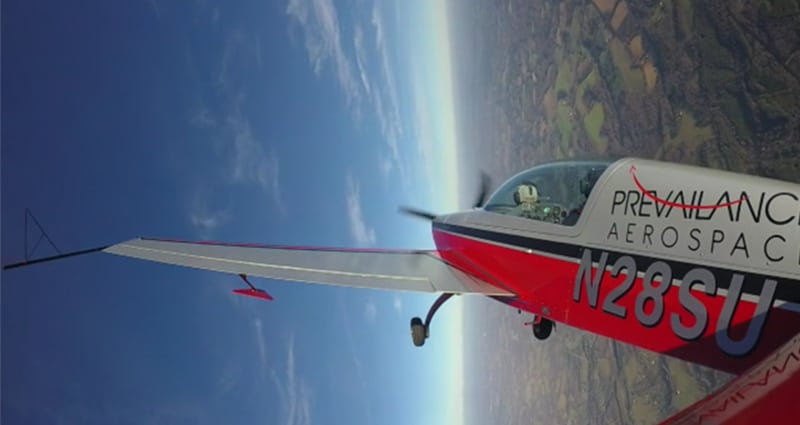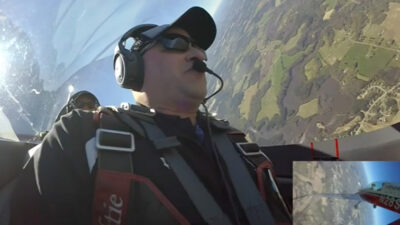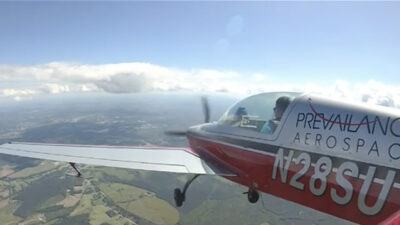Startle Who? Startle You!

After flying with hundreds of students as a flight instructor in the U.S. Navy then as a flight instructor in the GA realm, I can attest to the magnitude of the startle factor and the varied responses performed by pilots across every sector of aviation. These are not hobby pilots. These are pilots who clearly have their act together.
The largest number of students in my experience include three primary sectors – military aviators, corporate pilots from high-visibility organizations and student pilots enrolled in highly technical disciplines. Each one I trained was a professional pilot, or becoming one, with significant time and experience in their logbooks.
A Striking Need for Better Upset/Spin Training
After conducting upset and spin training for more than a decade, what continues to astound me is the inability of students to exercise the skill and talent possessed in the brief. This is prevalent when reacting to on-aircraft scenarios where each was asked to recover from an airborne situation that they had not anticipated. That is another testament to the reality of surprise, startle, and Loss of Control Inflight and how it impacts every pilot. As the FAA continuously documents, “fatal general aviation accidents often result from inappropriate responses to unexpected events.”1
Scripted Scenarios with Unanticipated Events
To further describe my assessment, I need to clarify the environment in which my data collection occurred. The bulk of this airborne training included scripted scenarios with unanticipated events that led to the pilot experiencing a surprise, to include inadvertent turbulence, a system anomaly or human factor that elicits the startle response.2 On most of the training flights, there was almost always a period of slow, and sometimes frozen, reactions to the “surprise” that was presented to the student. That is problem #1.
The other response that I am now accustomed to is severe and almost chaotic recovery activities. This is problem #2. Whether slow, frozen or chaotic, these problems require a solution that enhances piloting skills. I consistently emphasize that simulator training is not enough to counter startle and only in experiencing on-aircraft “emergencies” can any pilot truly understand how to manage the physiological response, or startle, that occurs.
In the below video, I had just finished two days of training with a highly accomplished pilot. On this day, after the prior six hours of ground instruction and two previous flights, his response to a holding scenario with an unexpected autopilot disconnect was more severe in magnitude than I anticipated or prepped for in the cockpit. When I say it was an aggressive response, I mean it was 4 Gs instead of 2 Gs in the pull out while simulating a commercial aircraft with passengers onboard.
I ended up further describing the scenario to my student in order to clarify the difference between 4 Gs and 2 Gs and how it would affect a recovery for the passengers onboard. Those 2 Gs used in a recovery could be the difference between a debrief item and structural failure.
This same scenario may have occurred in a simulator and would have been a point of note associated with limited Gs in recoveries. That is a great debrief point, but it does not provide the physical understanding of what a pilot goes through in this type of situation. I am certain that this pilot will not make that mistake again because he literally flew it and now knows the difference.
Startle: On-Aircraft Training is Vital
No pilot is immune to startle. I am consistently faced with unanticipated responses from pilots who should know better. Many 10,000-hour pilots do not understand the required control inputs when something unexpected happens, even when it is a controlled scenario in an airborne event. If an unexpected incident happened to one of these pilots at low altitude, it would be catastrophic as each would have little time and few options with regard to effectively executing a recovery. For all of the above reasons and in alignment with the video, my motivation for on-aircraft upset prevention and recovery training remains resolute.
Nothing prepares pilots for true startle like spinning toward the Earth and feeling the G forces necessary to recover. If pilots practice effective recoveries with simulated low altitudes in an actual airborne aircraft, they are better prepared for any unanticipated event (surprise!). On-aircraft training prepares pilots above and beyond anything they can experience in the simulator. It also makes recurrent simulator training more effective as each pilot develops muscle memory tied to recoveries in that specific aircraft.
Resources
1 Startle Response, FAA Safety Briefing, Retrieved on 11/28/2018 from: https://www.faa.gov/news/safety_briefing/2017/media/se_topic_17_06.pdf
2 Reducing Loss of Control Accidents in General Aviation, NTSB, Retrieved on 11/28/18 from: https://www.ntsb.gov/news/press-releases/Pages/nr20180419.aspx

Prevailance Aerospace is a UPRT provider that has been working with corporate, government, and general aviation pilots to improve safety in the aviation industry. Prevailance Aerospace uses Extra 300 Series Aircraft for training and our pilots are experienced aviation professionals from various military and general aviation backgrounds. We know that successful aviation endeavors are accomplished through an uncompromising commitment to safety, impeccable professionalism, tremendous attention to detail, and constant improvement.
http://prevailanceaerospace.com
© 2025 Prevailance Aerospace. All Rights Reserved.
Next ArticleRelated Posts

Rise Up for the Next Generation
There is no doubt in my mind that flying is the way mankind is meant to travel, yet the continued success and growth of the industry requires a refined approach to safety. As someone who flies commercially and with a new interest in a career in aviation, I want the reassurance that the pilot in command (PIC) and crew are adequately prepared if and when an aircraft ends up in an upset.

Three Considerations That Set Pilots Up for Success
Constantly reviewing aviation accidents and incidents is challenging. As an instructor, it is not only the injuries and fatalities that make it hard, but the sheer magnitude of avoidable aspects of each incident. These safety reports prove that every Pilot in Command (PIC) is accountable for what transpires.

